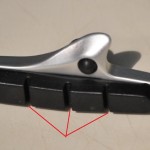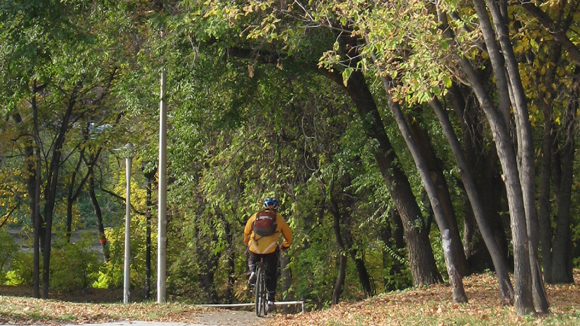With the leaves and temperatures falling many cyclists are deciding whether they should keep riding or pack the bike away and jump on the bus. Riding through the fall (or even much of winter) can be fun, but it does offer a few challenges. If you are instead putting the bike away until spring there are also a few things to consider. Either way, here are some ideas to help you prepare.
It’s getting dark out there
If you are planning to keep cycling through the fall the first thing that you need to consider is the reduced daylight hours that you are likely going to be cycling through. On November 6 we will be “falling back” to Standard Time and this will contribute even further to the need to ride in night time conditions.

Photo: Manitoba Public Insurance – by permission
One of the most important aspects of safe cycling is being visible and at this time of year that means having lights and reflective materials on you and your bike. The rules require cyclists to have a white or amber light on the front and a reflector on the rear of their bikes. Reflectors don’t really provide the kind of visibility you need so it’s a good idea to have a flashing LED light on the back. They greatly improve your visibility and are relatively inexpensive. Add a reflective safety vest and angle straps and you’ll be ready for the night.
Ice and leaf alert
Fall riding can present some challenging and even risky road conditions especially in the early morning when the temperatures fall below freezing. If you have wet streets combined with freezing conditions it is a good time to consider other transportation options or wait until it warms up a bit and the streets are free of any ice. Watch out as well for wet leaves piled up along the edge of the roads. They might look harmless enough but can also be very slippery.
Let’s stay warm, but not too warm
Dressing for fall riding is really no different than any cool weather activity. Dress in layers and if possible follow the basic principle of a perspiration wicking undergarment, an insulating layer and a wind-proof shell. If you have a longer ride you need to remember that you will build up some heat as you ride. If you are toasty warm when you walk out the door, you’ll be cooking hot when you arrive at your destination. Make sure that you keep your head and torso warm. If you don’t they will rob your extremities of heat and you’ll end up with cold hands and feet.
If the above has convinced you that riding in the cooler weather is not for you, it may be time to put that bike away for the winter. It is also be a good time for a bit of servicing. That way when spring arrives you are ready to go.
It’s easier in fall
Most shops are not as busy at this time of year and since you’re not in a hurry, it is a perfect time to get your bike in. Can’t afford to go to a bike shop, consider one of the many community bike shops where you can learn to do the repairs yourself. Check out The WRENCH for more information on community bike shops and upcoming opportunities to learn or volunteer.
I don’t think I need any repairs

Photo: Green Action Centre
Just ready to put it away, that’s easy! Before you do however, you might want to just check a few items that may yet need attention. Inspect the tires to make sure there is no cracking or even open cuts. You should also have a close look at the brake pads to make sure that they are not in need to replacement. Most brakes pads have wear indicators so that you can easily see if they are worn out. If you ride a fair amount you may want to get the wheel hubs and crank checked or possibly serviced to make sure they are in good running order for the next riding season.
I’m good, no repairs needed
Before you put it away it is a good idea to clean your bike. If possible clean it thoroughly, especially the drive components (chain, cogs, etc) however if it already too cold, you can just brush off any debris or dried mud from the frame and components with a stiff brush or rag. If you plan to leave the bike standing on its wheels, inflate the tires to make sure they don’t end up flat over the winter. The weight of the bike on a flat tire can distort and/or damage a tire over time. Lastly it is a good idea to lubricate the chain to reduce the potential for any rust forming. Make sure to use a lubricant designed to bike chains and don’t use WD-40 or motor oil.
If you have to store your bike outside, make sure that it is not sitting in an area that accumulates water. If ice forms around your rims the pressure created by the freezing water can bend the rim and make it irreparable. Cover your bike with a tarp to keep it at least somewhat safe from the elements.
If you are thinking of riding through the winter, check out this link for some tips.
If you have comments or ideas on riding in the fall or putting your bike away for winter we’d love to hear them.




Trackbacks/Pingbacks